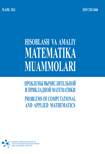Дискретная модель SWMB исследования передачи компьютерных вирусов
Ключевые слова:
отображение Лотка-Вольтерра, турнир, репеллер, аттрактор, спектрАннотация
Сегодня гораздо сложнее представить жизнь без компьютеров. Нет ни одной области, в которую компьютер не мог бы проникнуть. Повседневная жизнь стремительно оцифровывается и к сожалению, среди нас все больше и больше людей неправильно используют эту деятельность для достижения своих целей. Нам известен компьютер, который осуществляет свою деятельность с помощью специальных программ, написанных программистом. Это будет тот же срок для неправильных пользователей на пути к своей цели, то есть они будут зарабатывать на этом, создавая компьютерные вирусы. Этим и диктуется актуальность рассматриваемой задачи в работе. В данной работе мы расскажем о компьютерных вирусах и строим дискретную модель SWMB описывающую характер передачи компьютерных вирусов, в различных операционных системах. Для модели SWMB найдены неподвижные точки и изучены их характеры.
Библиографические ссылки
Yang X., Yang L. 2012. Computer Virus: Theory, Model, and Methods // Discrete Dynamics in Nature and Society P. 11.– DOI: 10.1155/2012/259671.
Ginsburg S. 1962. An Introduction to Mathematical Machine Theory, Addison-Wesley, Reading, MA.
Maurer W.D. 1965. A theory of computer instructions, Memorandum AIM-89, Artificial Intelligence Project,MIT, Cambridge, MA.
W.D. Maurer 1966. A theory of computer instructions, Journal of the ACM 226–235., vol. 13, no. 2,– P. 226–235.
P. Szor 2005. The Art of Computer Virus Research and Defense. Addison-Wesley
Anatoly Belous Vitali Saladukha 2020. Viruses, Hardware and Software Trojans Springer Nature Switzerland AG 2020. P. 822.
C. Sun and Y.H. Hsieh 2010. Global analysis of an SEIR model with varying population size and vaccination. Applied Mathematical Modelling, vol. 34, no. 10,– P. 2685–2697.
L.P. Song, Z. Jin, and G.Q. Sun. 2011. Modeling and analyzing of botnet interactions Physica A, vol. 390, no. 2,– P. 347–358.
J. Ren et al. 2012. “A delayed computer virus propagation model and its dynamics,” Chaos, Solitons Fractals, vol. 45.– №. 1.– P. 74-79.
B.K. Mishra and S.K. Pandey 2011. Dynamic model of worms with vertical transmission in computer network. Applied Mathematics and Computation, — 217. No. 21.– P. 8438–8446.
Ward Douglas Maurer 2006. A theory of computer instructions. Science of Computer Programming — 60. — P. 244–273.
Eshmamatova D. B., Tadzhieva M.A., Ganikhodzhaev R.N. 2023. Criteria for the Existence of Internal Fixed Points of Lotka-Volterra Quadratic Stochastic Mappings with Homogeneous Tournaments Acting in an (m-1)-Dimensional Simplex Journal of Applied Nonlinear Dynamics. 12, No.4. P. 679-688.
Tadzhieva M.A., Eshmamatova D.B., Ganikhodzhaev R.N. 2024. Volterra-Type Quadratic Stochastic Operators with a Homogeneous Tournament Journal of Mathematical Sciences. 278. No. 3. P. 546-556. doi: http://dx.doi.org/10.1007/s10958-024-06937-0.
Eshmamatova D.B. 2024. Compositions of Lotka-Volterra Mappings as a Model for the Study of Viral Diseases AIP Conference Proceedings.3085, No.1. doi: http://dx.doi.org/ 10.1063/5.0194902.
Eshmamatova D.B., Seytov Sh.J., Narziev N.B. 2023. Basins of Fixed Points for Composition of the Lotka–Volterra Mappings and Their Classification. Journal of mathematics. 44. No.2. P. 558-569 doi: http://dx.doi.org/10.1134/S1995080223020142.
Eshmamatova D.B. 2022. Compositions of Lotka-Volterra mappings operating in a two dimensional simplex, relation to viral diseases and their numerical analysis. Problems of computational and applied mathematics. 41, No.3. P. 79-92.
Devaney R.L. 2020. A First Course In Chaotic Dynamical Systems: Theory And Experiment.
Adleman L.M. 1988. An Abstract Theory of Computer Viruses. Advances in CryptologyCRYPTO’88, Springer.– P. 354-374.
Cohen F. 1986. Computer viruses : Ph.D Thesis.
Blaess C. 2002. Virologie: nimda, MISC. Le journal de la s´ecurit´e informatique, Num´ero. 1.
X. Han and Q. Tan 2010. Dynamical behavior of computer virus on Internet. Applied Mathematics and Computation. 217, No. 6.– P. 2520-2526.
Zhu Q. et al. 2012. Modeling and analysis of the spread of computer virus. Communications in Nonlinear Science and Numerical Simulation. 17, No. 12. P. 5117–5124.
Yang L.X. et al. 2013. A computer virus model with graded cure rates. Nonlinear Analysis: Real World Applications. 14, No. 1. P. 414–422.
Yang L.X. et al. 2012. A novel computer virus propagation model and its dynamics. International Journal of Computer Mathematics. 89, No. 17. P. 2307–2314.
Piqueira J. et al. 2005. Epidemiological models applied to viruses in computer networks. Journal of Computer Science. 1. No. 1. P. 31–34.
Balthrop J. et al. 2004. Technological networks and the spread of computer viruses. Science. 304, No. 5670. P. 527–529.

Загрузки
Опубликован
Выпуск
Раздел
Лицензия

Это произведение доступно по лицензии Creative Commons «Attribution» («Атрибуция») 4.0 Всемирная.



